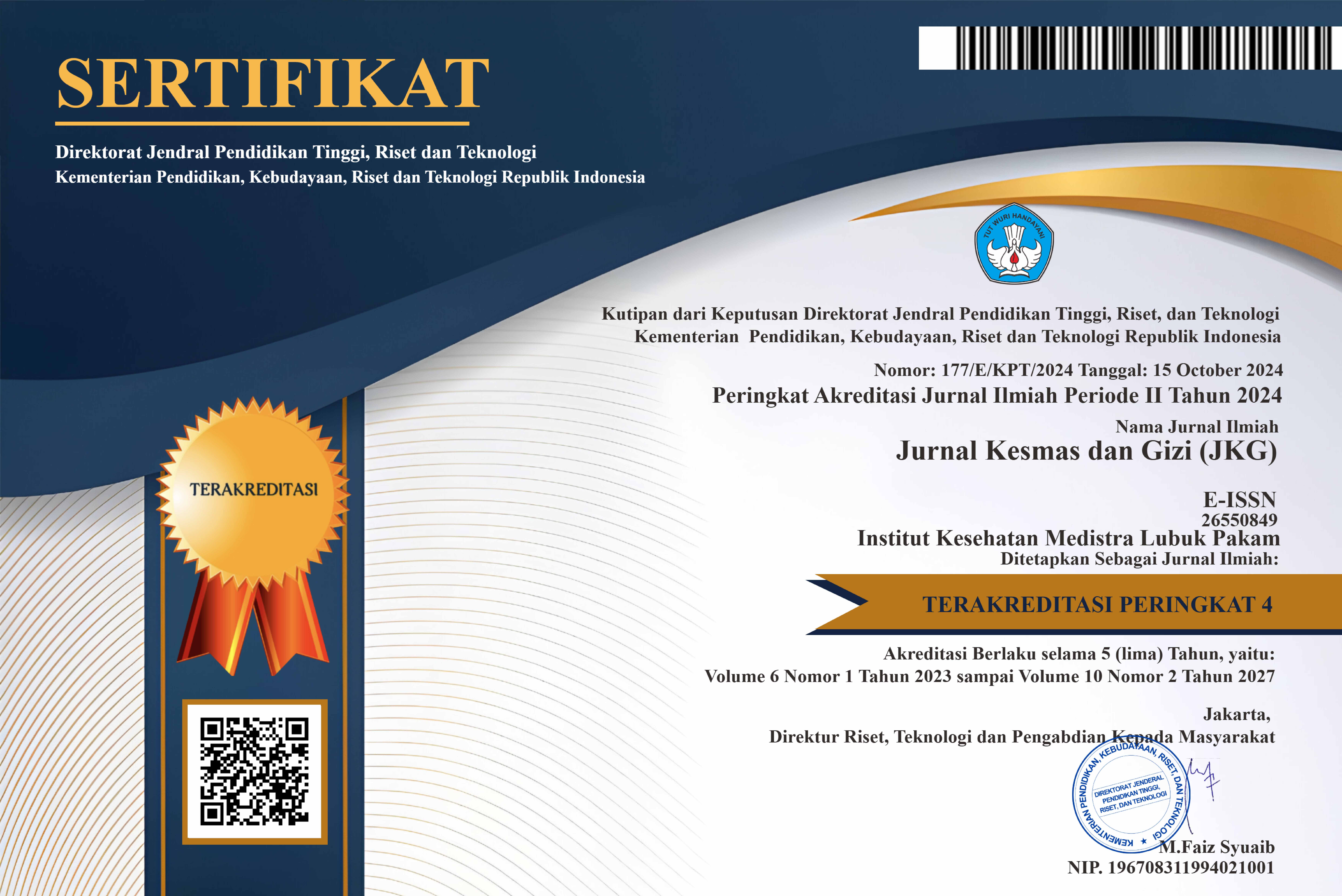The Correlation Between Preconception Body Mass Index And Upper Arm Circumference With The Incidence Of Anemia In Third-Trimester Pregnant Women In The Working Area Of Waru Public Health Center
DOI:
https://doi.org/10.35451/jkg.v6i2.2010Keywords:
Pregnancy anemia, BMI, UAC, PreconceptionAbstract
Anemia during pregnancy is a condition in which the body of pregnant woman experiences reduction in hemoglobin levels due to iron deficiency during pregnancy period, potentially causing complications. This research aims to determine the relationship between preconception body mass index (BMI) and upper arm circumference (UAC) with the occurrence of anemia in third-trimester pregnant women in the Waru Public Health Center working area. The method employed is quantitative analytic observational, using cross-sectional study design, and using secondary data taken from maternal antenatal care (ANC) records. Respondents were 94 third trimester pregnant women selected through simple random sampling technique. Data were analyzed using the chi-square test and calculation of the odds ratio (OR). The results indicated a prevalence of 53.2% for anemia occurring in third-trimester pregnant women in the Waru Public Health Center. Analysis using chi-square obtained p-value = 0.045 and OR = 2.329 for preconception body mass index (BMI) with the occurrence of anemia in third-trimester pregnancy, p-value = 0.276 and OR = 2.864 for preconception upper arm circumference (UAC) with the occurrence of anemia in third-trimester pregnancy. These results showed that there is a association between preconception body mass index (BMI) and the occurrence of anemia in third-trimester pregnancy, while there is no association between preconception upper arm circumference (UAC) and the occurrence of anemia in third-trimester pregnancy. It is expected that women of reproductive age who are preparing for pregnancy will maintain a normal nutritional status during the preconception period to prevent pregnancy anemia as an early intervention.
Downloads
References
Abrori, Hutagalung, K., Marlenywati. (2015). Faktor Risiko Anemia Pada Ibu Hamil Di Puskesmas Putussibau Selatan.
Aji, A. S., Yusrawati, Y., Malik, S. G., & Lipoeto, N. I. (2020). Prevalence of anemia and factors associated with pregnant women in West Sumatra, Indonesia: Findings from VDPM Cohort Study. Jurnal Gizi Dan Dietetik Indonesia (Indonesian Journal of Nutrition and Dietetics), 7(3), 97. https://doi.org/10.21927/ijnd.2019.7(3).97-106.
Aminin, F., Wulandari, A., & Lestari, R. P. (2014). Pengaruh Kekurangan Energi Kronis (KEK) dengan Kejadian Anemia pada Ibu Hamil. Jurnal Kesehatan, 5(2), 167–172.
Ariyani, Fitria Ayun. (2021). Determinant Kejadian Anemia pada Ibu Hamil Trimester I. Magelang:DIV Kebidanan Magelang.
Astuti, D., & Kulsum, U. (2018). Pola Makan Dan Umur Kehamilan Trimester III Dengan Anemia Pada Ibu Hamil. Indonesia Jurnal Kebidanan, 2(1), 24. https://doi.org/10.26751/ijb.v2i1.448.
Ayudia, F., & Putri, A. D. (2021). Pendidikan Gizi Prakonsepsi pada Pasangan Calon Pengantin di KUA Padang Utara. Jurnal Abdidas, 2(5), 1193–1196. https://doi.org/10.31004/abdidas.v2i5.457.
Harahap, P. Y., & Damayanty, A. E. (2023). Hubungan Pola Makan Dan Indeks Massa Tubuh Dengan Kejadian Anemia. Jurnal Kedokteran Dan Kesehatan?: Publikasi Ilmiah Fakultas Kedokteran Universitas Sriwijaya, 10(3), 309–316. https://doi.org/10.32539/jkk.v10i3.22064
Kementerian Kesehatan Direktorat Jenderal Pelayanan Kesehatan. (2022). Anemia dalam Kehamilan. Available from: https://yankes.kemkes.go.id/view_artikel/1132/anemia-dalam-kehamilan.
Mayasari, N. R., Hu, T. Y., Chao, J. C. J., Bai, C. H., Chen, Y. C., Huang, Y. L., Chang, C. C., Wang, F. F., Hadi, H., Nurwanti, E., & Chang, J. S. (2021). Associations of the pre-pregnancy weight status with anaemia and the erythropoiesis-related micronutrient status. Public Health Nutrition, 24(18), 6247–6257. https://doi.org/10.1017/S1368980021002627.
Maula, K. S. (2017). Hubungan faktor ibu dengan kejadian anemia pada ibu hamil remaja di Puskesmas Saptosari tahun 2014- 2015. Skripsi, 1–45. http://eprints.poltekkesjogja.ac.id/1559/.
Mutiarasari, D. (2019). Hubungan Status Gizi Dengan Kejadian Anemia Pada Ibu Hamil Di Puskesmas Tinggede. Jurnal Kesehatan Tadulako, 5(2), 42–48. https://jurnal.fk.untad.ac.id/index.php/htj/article/view/119.
Tan, J., Qi, Y. N., He, G. L., Yang, H. M., Zhang, G. T., Zou, K., Luo, W., Sun, X., & Liu, X. H. (2018). Association between Maternal Weight Indicators and Iron Deficiency Anemia during Pregnancy: A Cohort Study. Chinese Medical Journal, 131(21), 2566–2574. https://doi.org/10.4103/0366-6999.244109.
Triyonate, EM. Kartini,A. (2015). Faktor determinan anemia pada wanita dewasa usia 23-35 tahun. Journal of Nutrition College. Vol. 4, No. 2. Pp. 259-263.
WHO. (2021). Prevalence of anaemia in pregnant women (aged 15-49) (%) Location type Prevalence of anaemia in pregnant wome ... Prevalence, 2021. https://www.who.int/data/gho/data/indicators/indicator-details/GHO/prevalence-of-anaemia-in-pregnant-women-(-).
Wu, Guoyao. Dietary protein intake and human health. (2016). Food Funct. Vol.7. pp.1251-1265. DOI: 10.1039/c5fo01530h.
Downloads
Published
Issue
Section
License
Copyright (c) 2024 Abrillah Giosika Erinda Puteri, Lini Anisfatus Sholihah

This work is licensed under a Creative Commons Attribution 4.0 International License.
Copyright in each article is the property of the Author.


























